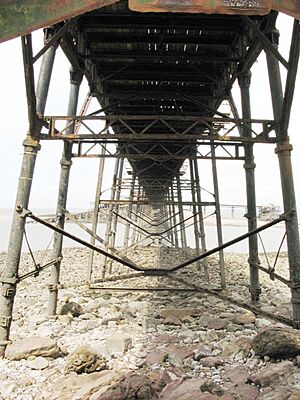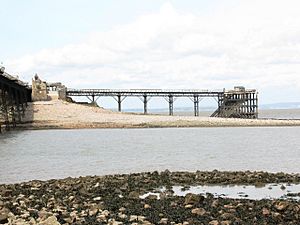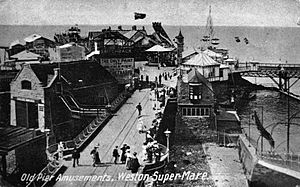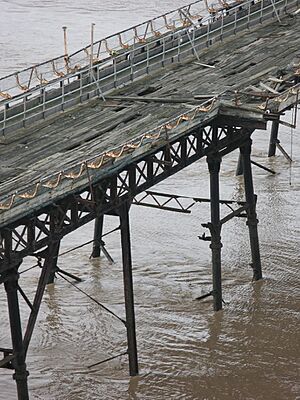Birnbeck Pier facts for kids
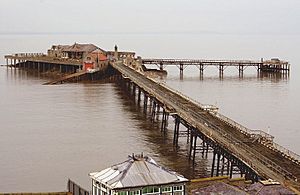
Birnbeck Pier and Island
|
|
| Official name | Birnbeck Pier |
|---|---|
| Type | Pleasure Pier with RNLI lifeboat station |
| Locale | Weston-super-Mare, Bristol Channel, England |
| Design | Eugenius Birch |
| Owner | CNM Estates |
| Total length | 1,150 feet (351 m) |
| Opening date | 5 June 1867 |
| Coordinates | 51°21′23″N 2°59′40″W / 51.3565°N 2.9945°W |
Birnbeck Pier, also known as the 'Old Pier', is a famous pier located on the Bristol Channel in Weston-super-Mare, England. It's about 18 miles (29 km) southwest of Bristol. What makes it special is that it's the only pier in the country that connects the mainland to an island! It links to Birnbeck Island, a small rocky island.
This pier was designed by Eugenius Birch and first opened in 1867. The cool gothic-style buildings at the entrance and pierhead were designed by local architect Hans Price. Sadly, the pier has been closed to visitors since 1994 and is now on a list of historic buildings that are at risk.
In the late 1800s and early 1900s, the pier was very popular with both local people and tourists. It was a busy spot for steamers (boats powered by steam) that traveled around the Bristol Channel. Over the years, the pier was changed and extended several times. During World War II, the pier was used by the British Admiralty for secret weapon research. After the war, it reopened, but fewer people visited. The last steamer trip to the pier was in 1979.
Since its closure, the pier has had many different owners. There have been lots of ideas to fix it up, but none have worked out. The pier is mostly in ruins today. Part of it even collapsed during a big storm in December 2015.
Contents
History of Birnbeck Pier
The island was originally called Bearn Back. This name comes from old English words meaning "The spring brook island". Over time, people started saying "Birnbeck". The island itself is made of limestone, which is a type of rock.
Before the pier was built, you could reach Birnbeck Island by walking across a natural path when the tide was low. In 1845, there was a plan to build a suspension bridge to the island. Work started two years later, but a storm damaged what little had been built. This stopped the bridge project.
Building the Pier
In 1864, a new idea came up: to build a pier to the island. Money was raised by selling shares, collecting £20,000. A special public holiday was declared in Weston-super-Mare on October 28, 1864, when a four-year-old boy named Cecil Hugh Smyth Pigott laid the first stone.
The main pier was originally 1,150 feet (351 meters) long and 20 feet (6 meters) wide. It was built using a special cantilever design. However, a part of the pier used for low tide landings was damaged in a storm in 1903. It was rebuilt but later taken down in 1923. Now, the pier is 1,040 feet (317 meters) long.
The pier looks a bit like a bridge because of its design. It's supported by 15 groups of strong piles (poles) that are screwed into the riverbed. Each group has four piles angled and braced together. This screw-pile method was an invention by Eugenius Birch, which helped many of his piers last a long time.
There were some problems with the pier shaking when bands marched on it, both on its opening day and again in 1886. To fix this, more braces were added to the piles. A rule was even made to ban marching on the pier! The beautiful gothic toll house and pierhead buildings were designed by local architect Hans Price.
To allow steamers to bring day trippers from other towns, a landing jetty was built on the west side of the island. The Severn Estuary, where the pier is located, has the second-highest tidal range in the world. This means the water level changes a lot between high and low tide. Because of this, the pier's legs are mostly visible at low tide and hidden at high tide.
How the Pier Worked
When the pier opened on June 5, 1867, it was a big celebration. Many people in Weston-super-Mare had a holiday. It cost 1d (an old penny) to walk on the pier, but this quickly went up to 2d. In the first three months, 120,000 people paid to visit! A small tramway was even installed to carry the luggage of passengers arriving by boat.
A new wooden jetty was added in 1872 on the north side. Another jetty was built in 1898 on the southwest side. This one reached deep water even at low tide, so steamers could use the pier at any time. However, it was damaged in a storm in 1903 and later removed. The northern jetty was also damaged but replaced with a new steel structure in 1905.
In 1904, another pier called the "Grand Pier" opened in the center of Weston-super-Mare. An electric tram ran along the seafront to the Birnbeck Pier.
Many visitors who arrived by steamer never left the pier or Birnbeck Island. They had everything they needed there: a cafe, a pavilion, amusements, and a funfair. These buildings were destroyed by a fire in 1897 but were rebuilt. The attractions included old-fashioned movie viewers (Mutoscope), a shooting gallery, a merry-go-round, swings, a "theatre of wonders," and a bar. In 1891, a telephone was installed on the pier, just six months after the first one in town! In 1909, the amusement area was made bigger.
During World War II, in 1941, the pier was taken over by the British Admiralty. It was named HMS Birnbeck and used for secret weapon development and testing. The famous "bouncing bomb" was even tested nearby. After the war, the pier went back to being a tourist spot. But it faced competition from the Grand Pier, which opened its own amusement arcades in 1946.
In 1962, the Birnbeck Pier Company sold the pier to P & A Campbell, the company that ran the steamers. After they stopped their boat trips, the pier was sold again. There have been many ideas since then to make the pier popular again, like turning it into a hotel, a casino, or even homes.
The "White Funnel" fleet of P & A Campbell was the most successful steamer company in the Bristol Channel. Their trips stopped during World War II. After the war, fewer people took boat trips because cheap foreign holidays became available. Also, the Severn Bridge opened in the 1960s, making it easier to travel by car. Regular ferry services to Birnbeck stopped in 1971, and the very last trip was in 1979. Today, pleasure steamers like the PS Waverley still operate in the Bristol Channel.
Challenges and Decline
In 1984, the pier was damaged by equipment that drifted during engineering work. The damage was quickly fixed. However, the pier was badly damaged again by storms in 1990 and closed for safety reasons in 1994. Daily trips to and from places like Cardiff and Clevedon were stopped. Because of its poor condition, English Heritage has put it on the Heritage at Risk Register. In 1999, the lifeboat station built a special walkway across the pier so their crews could safely reach the island.
In 2006, the pier was sold to a company called Urban Splash. They held a competition in 2007, asking people for ideas to bring the pier and island back to life. At that time, it was estimated that repairs would cost £4 million. Many designs were submitted from around the world. The winning design, announced in 2008, included luxury apartments and a hotel.
In 2010, Urban Splash put the pier up for sale again. In 2014, it was bought by CNM Estates. In 2015, the Victorian Society listed the pier as one of the ten most endangered buildings.
Part of the north pier collapsed during storms on December 30, 2015. In 2019, two men were sentenced for causing damage to the pier's clock tower. The judge noted that the tower had survived a fire, an attack during World War II, and an accidental mine explosion. He said the damage caused was "highly visible and irreparable."
In February 2020, North Somerset Council started a process to take ownership of the pier.
Weston Lifeboat Station
Because the Bristol Channel has such extreme tides, finding a good place to launch lifeboats has always been hard for the Royal National Lifeboat Institution (RNLI). In 1882, special cranes called davits were put on the pier. These allowed a lifeboat to be lowered into the water, even at low tide.
A new, larger lifeboat was placed here in 1889. A boathouse was built for it on the northeast side of the island, with a 100-foot (30-meter) slipway (a ramp for launching boats) next to the pier. This was replaced in 1902 by a new boathouse on the southeast side of the island. This one had a 368-foot (112-meter) slipway, which was the longest in England! It allowed the lifeboat to be launched during most tide conditions.
The long slipway was closed in 2007 because it was in poor condition. Since then, lifeboats have been launched from the northeast side of the island. The crews continued to use the 1889 boathouse. In April 2011, a new "temporary" boathouse was built to protect the two smaller lifeboats. This building cost £70,000 but was designed to be taken apart and reused elsewhere later. In 2015, the RNLI announced plans for a permanent lifeboat station at Knightstone Harbour. This meant the facilities on Birnbeck Pier were closed.
Weston-super-Mare is the busiest RNLI station on the south side of the Bristol Channel. In 2011, its two lifeboats were called out 42 times to help people. The most people ever rescued at one time was on September 22, 1884. Forty passengers were saved from the SS Welsh Prince after it got into trouble leaving the pier.


